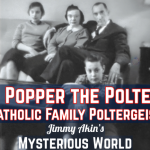
 Jimmy Akin's Mysterious World
Jimmy Akin's Mysterious World Popper the Poltergeist (Seaford, Catholic Family Poltergeist, RSPK, Jimmy Herrmann)
Jan 26, 2024
Jimmy Akin and Dom Bettinelli explore the infamous 1958 poltergeist case involving a Catholic family in New York. They discuss the strange events, such as popping bottle caps and moving objects, and explore theories behind the paranormal activity. They also investigate the possibility of a demon's involvement and test the effects of pressure on screw top bottles. The hosts discuss the weaknesses of the family hoax explanation and explore signs of suppressed anger and anxiety in one family member.
Chapters
Transcript
Episode notes
1 2 3 4 5 6 7 8 9 10 11 12
Introduction
00:00 • 3min
Introduction to the Seiford Poltergeist Case and the Herman Family
02:56 • 3min
The Popper Poltergeist Case
05:53 • 21min
Paranormal Events in the Home
27:00 • 16min
Exploring the Phenomenon of Poltergeists
42:35 • 16min
Theories and Perspectives on the Popper-Poltergeist Case
58:53 • 2min
Possible Demon Involvement
01:00:54 • 14min
Investigating the Effect of Pressure on Screw Top Bottles
01:14:51 • 2min
Analyzing the Wet Cap Incident
01:16:46 • 3min
Unsatisfactory Family Hoax Explanation
01:20:03 • 13min
Signs of Suppressed Anger and Anxiety
01:33:23 • 6min
Wrap Up and Teaser for Next Episode
01:39:18 • 4min

 One of the most pivotal poltergeist cases involved a Catholic family in New York in 1958. Jimmy Akin and Dom Bettinelli discuss the strange events, including popping bottle caps, and explore why this poltergeist case was so pivotal and what may have been responsible.
One of the most pivotal poltergeist cases involved a Catholic family in New York in 1958. Jimmy Akin and Dom Bettinelli discuss the strange events, including popping bottle caps, and explore why this poltergeist case was so pivotal and what may have been responsible.